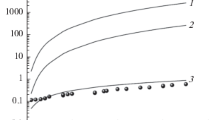Abstract
A population balance model has been proposed to describe simultaneous coagulation and fragmentation of fractal aggregates during shear-flocculation induced by means of a Couette-flow system. Given enough time, a floc-size distribution achieves the steady state, which reflects the balance between coagulation and fragmentation forces. Experimental results obtained recently show that higher shear rate values shift the steady state to smaller aggregate sizes. Also, for a fixed value of the shear rate, when the volume fraction of the particles increases, the steady state size increases if the flow is laminar, and decreases if the flow is turbulent. In order to model the fragmentation of the aggregates, a power dependence between the breakage rate coefficient and the shear rate has been proposed. The model is adjusted by using two different parameters: the effective probability of success for collisions αeff, and the break up coefficient for shear fragmentation, B′. The dependence of these two parameters on the shear rate and the volume fraction of the particles is discussed.
Similar content being viewed by others
References
Boadway, J.D., Dynamics of growth and breakage of alum floc in presence of fluid shear. J. Env. Engrg. Div. Proc. ASCE 104(EE5) (1978) 901–915.
Burban, P.Y., Lick, W. and Lick, J., The flocculation of fine-grained sediments in estuarine waters. J. Geophys. Res. 94(C6) (1989) 8323–8330.
Burban, P.Y., Xu, Y.J., McNeil, J. and Lick, W., Settling speeds of flocs in freshwater and seawater. J. Geophysical Res. 95(C10) (1990) 18213–18220.
Casamitjana, X. and Schladow, G., Vertical distribution of particles in stratified lake. J. Environ. Engrg. 119(3) (1993) 443–462.
Jiang, Q. and Logan, B.E., Fractal dimensions of aggregates determined from steady-state size distributions. Environ. Sci. Technol. 25(12) (1991) 2031–2037.
Kapur, P.C., Self-preserving size spectra of comminuted particles. Chem. Engrg. Sci. 27 (1972) 425–436.
Krishnappan, B.G., Madsen, N., Stephens, R. and Ongley, E.D., A field instrument for size distribution of flocculated sediment. Report of the National Water Research Institute, Canada, Berlington, Ontario L7R 4A6 (1996).
Lick, W. and Lick, J., Aggregation and disaggregation of fine-grained lake sediments. J. Great. Lakes Res. 14(4) (1988) 514–523.
Kiorboe, T., Andersen, K.P. and Dam, H.G., Coagulation efficiency and aggregate formation in marine phytoplankton. Marine Biology 107 (1990) 235–245.
Oles, V., Shear-induced aggregation and break up of polystyrene latex particles. J. Colloid Interface Sci. 154 (1992) 351–358.
Pandya, J.D. and Spielman, L.A., Floc breakage in agitated suspensions: Effect of agitation rate. Chem. Engrg. Sci. 38(12) (1983) 1893–1992.
Serra, T. and Casamitjana, X., Structure of the aggregates during the process of aggregation and break-up under a shear flow. J. Colloid Interface Sci. (in revision).
Serra, T., Colomer, J. and Casamitjana, X., Aggregation and break up of particles in a shear flow. J. Colloid Interface Sci. 187 (1997) 466–473.
Smoluchowski, M., Versuch einer mathematischen Theorie der Koagulations Kinetis kolloider Lösungen. Z. Physik. Chem. 92 (1917) 129–168.
Spicer, P.T. and Pratsinis, S.T., Coagulation and fragmentation: Universal steady-state particlesize distribution. AIChE 42(6) (1996) 1612–1620.
Tsai, C.H., Iacobellis, S. and Lick, W., Flocculation of fine-grained lake sediments due to a uniform shear stress. J. Great Lakes Res. 13(2) (1987) 135–146.
van Duurens, F.A., Defined velocity gradient model flocculator. J. Sanitary Engry. Div. 94(SA4) (1968) 671–682.
Wiesner, M.G., Wang, Y. and Zheng, L., Fallout of volcanic ash to the deep South China Sea induced by the 1991 eruption of Mount Pinatubo (Philippines). Geology 23(10) (1995) 885–888.
Williams, M.M.R., An exact solution of the fragmentation equation. Aerosol Sci. Tech. 12 (1990), 538–550.
Author information
Authors and Affiliations
Rights and permissions
About this article
Cite this article
Serra, T., Casamitjana, X. Modelling the Aggregation and Break-up of Fractal Aggregates in a Shear Flow. Flow, Turbulence and Combustion 59, 255–268 (1997). https://doi.org/10.1023/A:1001143707607
Issue Date:
DOI: https://doi.org/10.1023/A:1001143707607



